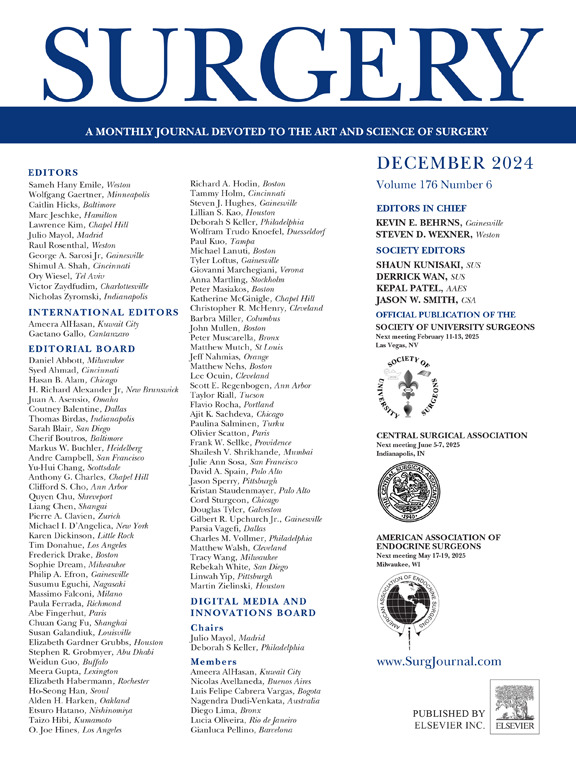Clinical implications of postoperative hyperamylasemia and postpancreatectomy acute pancreatitis after pancreatectomy: A systematic review and meta-analysis
IF 3.2
2区 医学
Q1 SURGERY
引用次数: 0
Abstract
Background
Since its definition in 2022, postpancreatectomy acute pancreatitis has been increasingly recognized as a critical postoperative entity, but its clinical significance has not been evaluated through systematic review and meta-analysis. The aim of current study was to evaluate the clinical implications of postoperative hyperamylasemia and postpancreatectomy acute pancreatitis according to the International Study Group for Pancreatic Surgery consensus definition.
Methods
A systematic review with meta-analysis was conducted in PubMed, EMBASE, and Cochrane Library databases. Studies published between January 2022 and August 2024 that used the International Study Group for Pancreatic Surgery definitions for postoperative hyperamylasemia and postpancreatectomy acute pancreatitis were included. Risk ratios with 95% confidence intervals were calculated using a Mantel-Haenszel random-effects model.
Results
Eleven studies were included in the meta-analysis. Postoperative hyperamylasemia was associated with increased postoperative pancreatic fistula rates (risk ratio, 0.33; 95% confidence interval, 0.21–0.51; P < .001). Postpancreatectomy acute pancreatitis was associated with greater rates of postoperative pancreatic fistula (risk ratio, 0.24; 95% confidence interval, 0.17–0.35; P < .001), postoperative pancreatic hemorrhage (risk ratio, 0.39; 95% confidence interval, 0.26–0.59; P < .001), delayed gastric emptying (risk ratio, 0.57; 95% confidence interval, 0.41–0.79; P = .007), Clavien-Dindo classification IIIa or greater complications (risk ratio, 0.38; 95% confidence interval, 0.25–0.58; P < .001), mortality (risk ratio, 0.42; 95% confidence interval, 0.27–0.65; P = .001), and longer hospital stays (mean difference, −7.76 days; 95% confidence interval, −12.52 to 3.00; P = .001).
Conclusion
This first meta-analysis exploring their clinical significance demonstrates that both postoperative hyperamylasemia and postpancreatectomy acute pancreatitis are associated with increased postoperative complications after pancreatectomy. The adoption of these definitions in clinical practice could significantly impact the postoperative course by early stratifying patients at higher risk for additional morbidity.
胰切除术后高淀粉酶血症和胰切除术后急性胰腺炎的临床意义:系统回顾和荟萃分析
自2022年定义急性胰腺炎以来,胰腺切除术后急性胰腺炎已越来越被认为是一种重要的术后疾病,但其临床意义尚未通过系统综述和荟萃分析进行评估。本研究的目的是根据国际胰腺外科研究小组的共识定义,评估术后高淀粉酶血症和胰腺切除术后急性胰腺炎的临床意义。方法对PubMed、EMBASE和Cochrane Library数据库进行系统评价和meta分析。在2022年1月至2024年8月期间发表的研究中,使用了国际胰腺外科研究小组对术后高淀粉酶血症和胰腺切除术后急性胰腺炎的定义。采用Mantel-Haenszel随机效应模型计算95%置信区间的风险比。结果meta分析纳入了6项研究。术后高淀粉酶血症与术后胰瘘发生率增加相关(风险比,0.33;95%置信区间为0.21-0.51;P & lt;措施)。胰腺切除术后急性胰腺炎与较高的术后胰瘘发生率相关(风险比,0.24;95%置信区间为0.17-0.35;P & lt;.001),术后胰腺出血(风险比,0.39;95%置信区间为0.26-0.59;P & lt;.001),胃排空延迟(风险比,0.57;95%置信区间为0.41-0.79;P = .007), Clavien-Dindo分级为IIIa级或以上并发症(风险比0.38;95%置信区间为0.25-0.58;P & lt;.001)、死亡率(风险比0.42;95%置信区间为0.27-0.65;P = .001),住院时间较长(平均差异为- 7.76天;95%置信区间为−12.52 ~ 3.00;P = .001)。结论本荟萃分析首次探讨了其临床意义,表明胰腺切除术后高淀粉酶血症和胰腺切除术后急性胰腺炎与胰腺切除术后并发症的增加有关。在临床实践中采用这些定义可以通过早期分层增加发病率高风险的患者来显著影响术后过程。
本文章由计算机程序翻译,如有差异,请以英文原文为准。
求助全文
约1分钟内获得全文
求助全文
来源期刊

Surgery
医学-外科
CiteScore
5.40
自引率
5.30%
发文量
687
审稿时长
64 days
期刊介绍:
For 66 years, Surgery has published practical, authoritative information about procedures, clinical advances, and major trends shaping general surgery. Each issue features original scientific contributions and clinical reports. Peer-reviewed articles cover topics in oncology, trauma, gastrointestinal, vascular, and transplantation surgery. The journal also publishes papers from the meetings of its sponsoring societies, the Society of University Surgeons, the Central Surgical Association, and the American Association of Endocrine Surgeons.
 求助内容:
求助内容: 应助结果提醒方式:
应助结果提醒方式:


